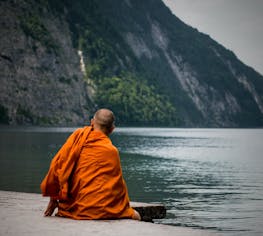Wherever You Go, There You Are Summary
Mindfulness Meditation in Everyday Life
Are you interested in deepening your understanding of mindfulness, and learning how to meditate?
Wherever You Go, There You Are, explores mindfulness, why it matters, and how we can incorporate it into our lives. It's unique because it caters to those coming to meditation for the first time, and for those who are longtime mindfulness practitioners. It's also handy for those who are curious but don't necessarily want a structured program.
Or perhaps you're just looking to piece things together for yourself, and gain some ideas and suggestions along the way?
The founding father of "modern mindfulness," Jon Kabat-Zinn, aims to teach us what mindfulness is, and how we can fully tune into the present moment, letting go of our constant worries about the past and the future. Kabat-Zinn is a professor of medicine, and an emeritus professor from the University of Massachusetts medical school. He founded the Stress Reduction Clinic at the University of Massachusetts. He's studied under renowned Buddhist teachers like Thich Nhat Hanh, and leads workshops on stress-reduction and mindfulness.
We'll briefly unpack how Kabat-Zinn defines the term mindfulness. Then we'll look at some suggestions on how to practice this ancient technique. His mission is to connect mindfulness with science, and make it more accessible to Westerners. By helping us understand what mindfulness is (and isn't), he provides us with simple, practical ways to increase our capacity to be mindful in everyday life.
Where's Your Mind Right Now?
How often have you read a page of a book, only to get to the end, with no idea about what you've just read?
For many of us, instead of focusing on the page, our thoughts often drift to planning the next meal, or reflecting on something our boss said earlier. The point is, we're seldom mentally in the present moment.
Our bodies might be in the "here and now," but often, our minds are elsewhere. Our minds might journey to a picturesque beach and soak up the summer breeze, but in reality, we're sitting in the office, staring at our computer. Our minds flit from stories we construct about the past, or a future that's still on its way. We do mental time-travel, but seldom do we apply the brakes and embrace the present moment as it unfolds. Kabat-Zinn says it's as if we live in a "fog-enshrouded state," and if we're not careful, these cloudy moments can stretch out and become most of our lives.
From the Buddhist perspective, our ordinary waking state of consciousness is considered severely limited. We live more in a dream-like state than we do in an awakened one. We aren't entirely in tune with ourselves, nor the present moment as it unfolds. And we pay a high price for this way of being. We miss out on the richness of present moments, and lose touch with who we are and what possibilities are available. The days, months, and years quickly go by unnoticed, unused and unappreciated.
A diminished awareness of the present moment can inevitably leave us feeling stuck and out of touch. What would it be like if we're able to wake up?
Mindfulness Is an Ancient Practice With Profound Relevance to Our Present-Day Lives
Mindfulness offers us an opportunity to "wake-up" to the present moment, and get back in touch with our inner wisdom and vitality.
Mindfulness is a simple concept, but its power lies in the practice and its applications. Kabat- Zinn defines mindfulness as 'paying attention in a particular way, on purpose, in the present moment and non-judgmentally.' This kind of attention nurtures greater awareness, clarity, and acceptance of present-moment reality.
Kabat-Zinn describes mindfulness simply as 'the art of conscious living.' He says, 'You don't have to be a Buddhist or a Yogi to practice it.' Fundamental to Buddhist teaching is simply being ourselves, and tuning into our wisdom rather than trying to be more than we are already. One of Kabat-Zinn's students said, 'When I was a Buddhist, it drove my parents and friends crazy, but when I am a Buddha, nobody is upset at all.' Inherent to Buddhist mindfulness practice is to be in touch with our most profound nature, and let it flow out of us unimpeded. Kabat-Zinn says, 'It's about waking up and seeing things as they are.' The word "Buddha" simply means, one who has awakened to his or her true nature.
Despite its Buddhist roots, mindfulness isn't in conflict with any beliefs, scientific or otherwise, or traditional religions. There's no trying to sell us on anything, and it's not a new belief system or ideology. It's merely a practical way to become more in touch with the fullness of our being through a systematic process of self-observation, self-inquiry, and mindful action.
Let's now turn to the art of mindful practice.
Being in the Moment and Concentrating on One Thing at a Time
Concentration is the cornerstone of mindfulness.
The Sanskrit word 'Bhavana' can be translated into English as 'meditation,' but more specifically, it means "cultivation." Meditation is the process by which we cultivate and deepen our capacity for attention and awareness, and use this skill in all areas of our lives. However, to concentrate on just one thing, to the exclusion of all else, isn't something that comes naturally to most of us.
Think back to school. How often were you told to "pay attention?"
The thing is, it's likely that no one ever taught you how to pay attention? Our author believes that most of us assume that attentive awareness, and focused concentration is a given – a skill that comes naturally, without practice. Most of us don't develop a process where we learn how to pay attention in a way that helps us to anchor ourselves in the present moment, and calm our busy minds.
Kabat-Zinn believes that the ability to focus on just one thing is the hallmark of happiness. Developing our concentration muscles means noticing when our mind is wandering, and bringing it back to a focal point. This development helps us step out of negative rumination, and not get caught up in our anxieties about the future. When we fully concentrate on something, our energy is directed towards deeply experiencing that one thing, or a specific moment. Everything else falls away, including other thoughts, feelings, and the outer world. This often leads to feelings of stillness and undisturbed peace.
However, concentration alone isn't the sole purpose of meditation. The spirit with which we practice matters.
Practicing Both Mindfulness and Heartfulness
The felt experience of mindfulness should be gentle, appreciative, and nurturing. Kabat-Zinn points out that 'Mindfulness could have been translated as heartfulness, as in many ancient Asian languages mind and heart means the same thing.'
The heart's qualities that we bring to our practice include patience, non-judgment, acceptance, letting go, and generosity. We're continually judging the stream of thoughts and emotions that run through our minds, and we tend to label them as good or bad. We get trapped in a state of tension, constant craving for, or aversion towards thoughts, feelings, and events around us. So rather than judge, we can practice accepting things as they are in the moment. Acceptance isn't a stoic, passive resignation towards the realities we face, but rather an active recognition that things are the way they are. Kabat-Zinn reminds us of the serenity prayer, 'God, grant me the serenity to accept the things I cannot change, courage to change the things I can, and wisdom to know the difference.'
Coupled with non-judgment and acceptance is the practice of letting go. Letting go is the opposite of grasping and clinging to what we want, and trying to push away what we don't want. To let be and let go is no easy task, especially if we're holding onto hurt and anger.
Patience is the cornerstone of mindfulness, and in the contemporary world, our patience is tested continuously. We spend much of our lives waiting – in grocery store lines, for email replies, or for someone to finally apologize. When patience wears thin, anger sets in, and here let's turn to the Dalai Lama for advice. Despite the Chinese government's acts of violence against the Tibetan people, the Dalai Lama allowed himself to apply understanding and patience. Rather than focusing on anger over what was happening to his fellow Tibetans, he channeled feelings of empathy.
Holding onto anger can be like grasping a hot piece of coal, and throwing it at our enemy; we're likely to get burned in the process. As Kabat-Zinn says, 'If somebody takes something from you, don't let them take your mind too.' If we find that we start to get angry, we can remember that wisdom is found in patience, and rather than just reacting, we can learn to respond in ways that better serve ourselves and others.
As we develop acceptance and patience, we find that the energy to serve others comes from a place of compassion and generosity. Meditation practice helps us to discover and use our gifts to serve others better.
With this in mind, let's turn to some practical ways to incorporate meditation practice in our daily lives.
Practicing Mindfulness Formally and Informally
We don't need a special occasion, a fancy cushion, or a remote island location to practice mindfulness. All we need to do is carve time out of our day, find a place where we'll be undisturbed, and commit to a daily mindful practice. Mindfulness practice isn't a time to solve any problems, think positively, or reach any goals. The intention here is to step out of the doing mode, and step into the mode of being. It's a time where we learn to focus on the present moment, and practice focusing our attention on our body, the breath, and moment-to-moment sensations. Kabat-Zinn describes it as "homecoming," where we come home to ourselves, and the present moment.
If you choose to do a sitting practice, remember you don't have to torture yourself in lotus positions or feel uncomfortable. We can use a chair or a cushion to support us, but the key is to sit upright in a way that makes us feel present, but relaxed. Our posture talks to us when we sit down to meditate; it makes its own statement. If we slouch, it reflects low energy, passivity, and a lack of clarity. However, if we sit ramrod-straight, we're tense and trying too hard. There's a lot of confusion about the "right way" to sit in meditation. Kabat-Zinn's advice is to 'Sit in a way that embodies dignity.' He says, 'Everybody seems to instantly know that inner feeling of dignity, and how to embody it.'
Once we've found a way to sit that suits us, we can then direct our thoughts to the most basic of things - the breath. And when our mind wanders (as it almost certainly will), we simply return to our breathing. We need to do this time and time again. Bringing ourselves back to a simple focus on our breath is a reminder that we can anchor ourselves in the present moment.
You might be wondering how much time should be set aside for formal practice? Our author personally sets aside forty-five minutes for his morning meditation routine. However, the length of time we commit to "formal" meditation is up to us. If the idea of sitting still, especially for more extended periods, seems too challenging, we can also practice mindfulness when sitting, standing, walking, or even lying down. If we're lying down, we can try to do a body scan. The goal here isn't to fall asleep but, as our author puts it, "fall awake" to the body and the changing sensations from moment to moment. Kabat-Zinn reminds us that there's no right or wrong meditation practice. So use the above steps as a guideline, but keep in mind that the most effective approach is the one that feels right for us.
Formal practices have a snowball effect. Formal practices inform us as to how we can incorporate mindfulness more informally into our everyday lives. Let's use an example of an activity that we habitually perform in auto-pilot mode, like climbing the stairs. We tend to rush up and down a staircase without thinking about it. What if we climbed stairs mindfully? What if, as each foot reached the next step, we noticed which part of our foot touched the step first. We could also sense the cold surface of each step. Doing this could allow us to see what it feels like when our knee bends, and how our arms move accordingly. The idea is to slow down, taking one step at a time, to increase presence and awareness.
Mindfulness is a reminder to live our lives as fully as possible. As our author says, 'there's no place you need to be, and no moment that you need to sacrifice for the sake of being fully present in this one.'
Let's now look at some of the most common stumbling blocks, and how to get past them.
Don't Mistake Simple, for Easy
Have you ever heard of the word "selfing?"
This mindset keeps the attention on the 'self,' and adds the idea of 'my,' into everything we do. Everything becomes "my experience," "my perspective." Mindfulness helps us shift to an understanding that we don't have to personalize everything; and that everything is impermanent and in a state of flux.
What if for a moment, we sat on the banks, instead of inside our thought-stream, watching our thoughts flow by? We think virtually all the time; our thoughts are like a constant stream, leaving us with very little space for "inner quiet." We get caught up in the current of our unconscious thoughts, fears, insecurities, and impulses that drive our actions, often leading us to places we may not wish to go. Meditation means learning how to step out of this turbulent current and, instead, place ourselves along the bankside. From the bankside, we can observe our thoughts just as thoughts, not believing or attaching to them, just listening and learning from them. This allows us to tap into a spacious awareness within. We can learn to see that we have multiple choices in any given situation. We don't have to take everything personally, and we can respond rather than react to whatever arises.
The cultivation of mindfulness and meditation is often confused with relaxation or self-improvement. Mindfulness isn't about aiming for a particular feeling, nor is it about getting somewhere or becoming a specific kind of person. Instead, mindfulness enables us to see more clearly and, therefore, understand the areas in our lives that we are out of touch with, or unwilling to think about.
The practice of mindfulness puts us in touch with many aspects of our lives that are habitually overlooked or lost. This means that we're likely to encounter deep emotions such as grief, sadness, woundedness, anger, and fear. These are emotions that we frequently don't allow ourselves to hold or express consciously. As hard as it is to feel these difficult emotions, it's necessary to experience them. Because if we shut out the complicated feelings, we shut out the good ones too. Being mindful allows us to appreciate deep feelings of joy, peacefulness, and happiness, which are too often fleetingly and barely acknowledged. Mindfulness is enlightening and liberating work. It can lead to new ways of being with ourselves and in the world.
In Conclusion
Some of us might be longtime mindfulness practitioners, while others might be neutral or skeptical. Regardless of which camp we fall into, Wherever You Go, There You Are, is a book for all of us. Through his own personal and professional experience, our author writes about the philosophy and practice of mindfulness, which is essentially a non-verbal experiential practice.
In his book A Painful Case, James Joyce writes about a character called Mr. Duffy. Joyce writes, 'Mr. Duffy lived a short distance from his body.' These words carry wisdom that applies to us all, and encapsulate the spirit of this book. It's easy to feel as if we live a short distance from ourselves, and life's precious moments in our fast-paced and technology-driven world. To come home to ourselves and the present, is perhaps the real art of living. Despite its newfound popularity, mindfulness is an ancient and universal practice, that's not a quick-fix to feel good, but rather a deep, ongoing practice that reminds us, that 'Wherever you go, there you are.'
As Kabat-Zinn says, 'Ultimately, meditation is not the goal in itself. It's a vehicle to help us live as fully as possible.'




